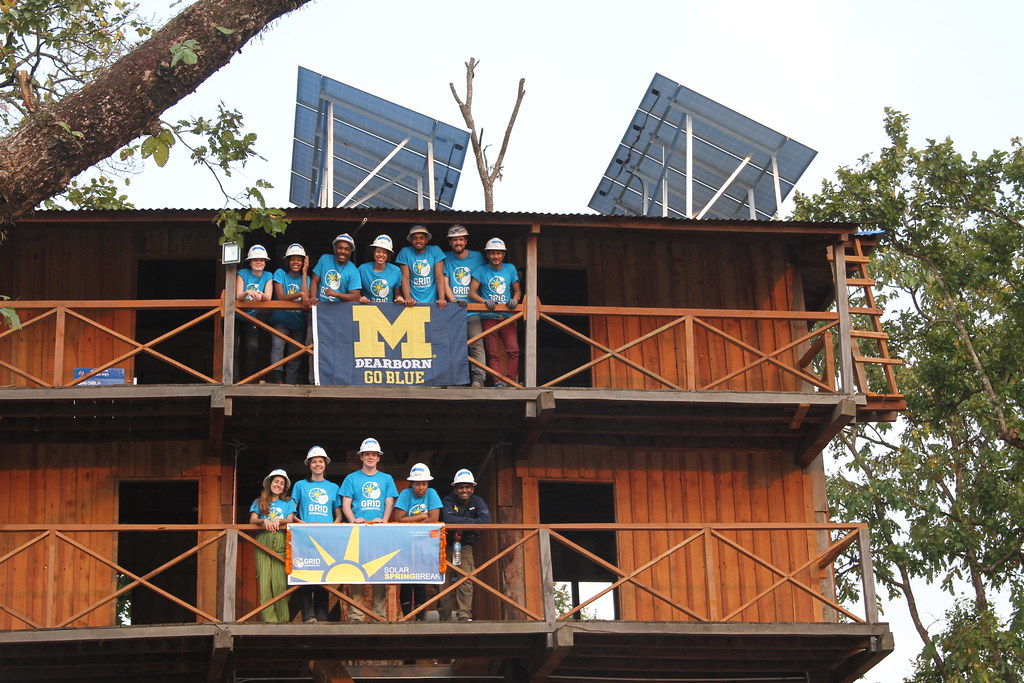
Sustainable energy is a growing field, with opportunities for students working toward a number of different majors, especially in engineering. But when two students saw a need for more ways to develop hands-on experience on the University of Michigan-Dearborn campus, they took the lead to launch a collaboration with a national organization providing just that.
Christian Cannon and Alexis Thompson not only brought GRID Alternatives to UM-Dearborn but — as co-presidents of the university's student chapter — united the group with the Ann Arbor campus to provide meaningful experiences installing solar energy systems in San Diego County, Los Angeles and even Nepal. Cannon — a 2024 environmental science graduate — now works as a clean energy business development intern at Walker-Miller Energy Services in Detroit. Thompson has been working as a consultant for sustainability projects while completing her degree in mathematics, with a certificate in geographic information systems.
Cannon and Thompson began exploring a partnership with GRID Alternatives, the largest nonprofit solar installer in the United States, out of a shared interest in gaining hands-on experience in the clean energy field. While attending the Solar Power International conference in Las Vegas in 2017, they met Tim Sears and Erica Mackie, the co-founders of GRID Alternatives, who helped connect Cannon and Thompson with the then-leaders of their affiliated student group chapter — GRID Alternatives Students for Sustainable Energy — on the UM-Ann Arbor campus. Soon after that meeting, Cannon and Thompson became the co-presidents of a newly united U-M chapter under the guidance of faculty advisor Tony Reames, an associate professor in U-M’s School of Environment and Sustainability, and Eva Gogola, UM-Dearborn’s director of annual giving and advancement services.
Students participating in GRID take part in an immersive service-learning opportunity called Solar Spring Break, providing students with hands-on experience at GRID locations in different regions throughout the country and abroad. The students also volunteer to install solar panels in low-income neighborhoods. "This work represents an invaluable opportunity for students to gain real-world experience in the clean energy industry," Cannon says.
One challenge student-run organizations face, however, is funding. Like GRID-affiliated chapters across the U.S., the U-M chapter had to raise money for the solar installation equipment, travel and other expenses. Thompson stressed the need for equity in these efforts, pushing back against the trend that the students who are able to participate in such opportunities are only those who can personally afford to do so. "One of the things we wanted, which has not always been the case with other GRID campus groups, was to send people to work in these communities who look like those communities," Thompson says.
Cannon and Thompson worked closely with Mariah Fiumara, director of U-M’s Engineering Center for Student Organizations, to raise funds through competitive grants, business sponsorships and local fundraising efforts, while Ann Arbor GRID member Camille Burke, a 2020 grad, rallied support from other student-run organizations. The group raised more than $100,000, which supported a dedicated team of 100 students from both campuses. "I want to stress that this is something students can do, that it is possible," Thompson says. "We want this work to continue for UM-Dearborn and Ann Arbor students."
The group took part in three Solar Spring Breaks, the first installing solar energy systems on the La Jolla Indian Reservation near San Diego, the second installing in residential homes in Los Angeles and the most recent on the Kumal Tower in Nepal's Chitwan National Park. Together, these initiatives represent more than 40 kW of solar capacity — an amount that can typically supply electricity to about 10 average U.S. homes while offsetting 40 tons of carbon dioxide.

"Our campus was the first university to conduct an international trip through GRID Alternatives’ Solar Spring Break program," Cannon says of the group's work in Nepal. The idea for an international installation took root with the group's first experience on the La Jolla Reservation, where the proximity to Tijuana, Mexico, inspired the team to provide sustainable energy to lower-income areas beyond U.S. borders. While the logistics were unfavorable for a Solar Spring Break in Mexico, the students found an ideal opportunity to do meaningful work rehabilitating Nepal’s Kumal Tower, a disused watchtower that previously did not have a functioning power supply, converting it into a fully functional wildlife observation center.
Members of GRID Alternatives Students for Sustainable Energy found their experiences installing solar energy systems meaningful on both professional and personal levels. “Working with GRID Alternatives taught me how my engineering skills could make sustainable energy accessible to those who need it most," says Yesha Lester, a 2019 UM-Ann Arbor grad. "I gained hands-on experience with solar technology and saw the power of community-focused projects. Knowing our work would lower a family’s bills made the project rewarding and showed me that engineering is about improving lives, not just solving technical problems.”
While GRID has not been active at UM-Dearborn since 2022 because Solar Spring Break programs were paused for the pandemic, Cannon has been speaking with other sustainability groups on campus about adopting solar work and leading more sustainability-focused international projects in the future. He says the rewards for interested students are well worth the effort: "Working with GRID Alternatives has deepened my academic learning and shaped me into a leader within the clean energy industry.”
###
Story by Shaun Manning. Photos courtesy of Christian Cannon.




